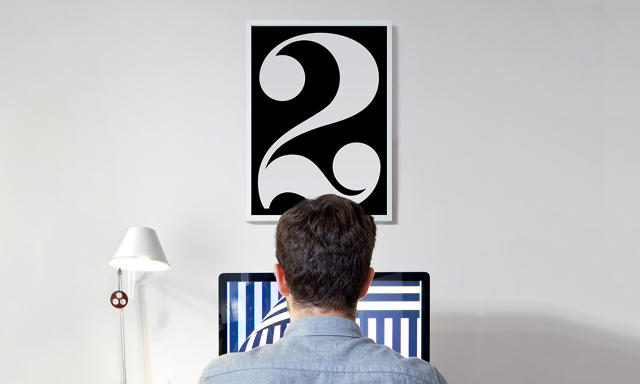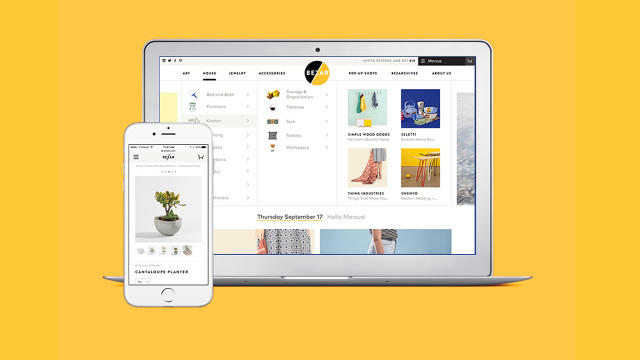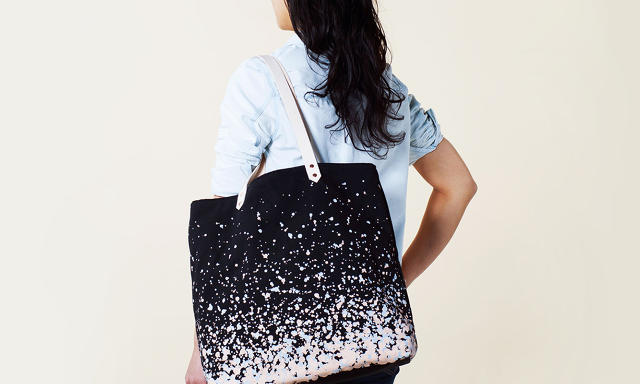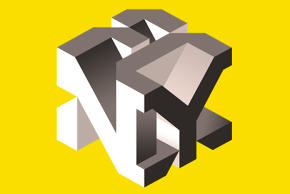Bradford Shellhammer’s Bezar Launches Designer Storefronts
The new arm of the design site will feature designer-focused tools, no owl sweaters allowed.
The last time Fast Company spoke with Bradford Shellhammer, he was launching his first post-Fab endeavor: the design website Bezar, which focused on flash sale-like pop-up shops.
Now the seven-month-old company is launching Storefronts: user profiles and pages for select designers to permanently host their wares, with backend tools to help them sell products through Bezar without the company having to take on inventory or additional staffers (14 people currently work there).

The new platform is meant both as a tool for emerging designers to get in front of shoppers and for potentially hosting collaborative exclusives with bigger, more established brands. Instead of the three-day flash sales, Storefronts will host designers’ work 24/7 and coexist with the existing Bezar hub of pop-up shops, while cross promoting offerings from the designer pages, when opportune.
The flash sale model meant beautiful products, Shellhammer says, but it posed some innate problems—SEO, for one. If a shopper didn’t pull the trigger in time, they’d never find the product (or its designer) again.
“Flash is really awesome if you’re someone like myself who loves the thrill of shopping and loves to be enticed visually and loves to make emotional purchases that are spontaneous,” Shellhammer tells Fast Company. “But if you’ve just moved into a new apartment in Brooklyn, and you need to decorate, and you have a wall where you need a poster and you need a rug—we really suck for that shopper right now.”

The shift to designer-hosted shops comes in the midst of a handmade marketplace push from e-commerce giants Etsy and Amazon.
But Shellhammer insists Bezar is different. While Storefronts are meant to be a supportive tool for creators, it’s leagues away from the craft movement and Amazon’s brand of retail.
“A lot of our designers could set up a shop on Amazon. They could set up a shop on Etsy, if they’re handmade. But most of our designers are not craftspeople. It’s not a hobby. It’s not one-of-a-kind pieces. Most of the things that we sell are mass-produced, have some kind of production run. There may not be thousands sitting on a shelf, but there’s definitely hundreds at a time,” Shellhammer says. “I shop on Etsy all the time. But Etsy is not where you’re going to find a molded plastic chair. And a designer doesn’t want to be on the same platform as knitted owl sweaters or Christmas trees. I don’t say that to be condescending or snarky, because craft does belong in the conversation of design. But they’re two very different things. What we want to build is a marketplace for design.”
What Etsy is to crafts and 1stDibs to antiques, he intends for Bezar to be for design: A central hub for designers to be discovered for furniture, housewares, modern art, and jewelry (not fashion).
And with Storefronts, Shellhammer’s team will be able to cross-promote items from the flagship pop-up side of the business and vice versa.
“One thing I can’t do right now is tell other merch stories. I can’t pick typography posters that cut across different designers. I can’t do products under $25, or perfect Mother’s Day gifts,” says Shellhammer. “And now that we actually have product sitting on the shelf and we have the functionality that can cross merchandise and cross designers, I can start telling different kinds of stories: kitchen stories, living room stories, essentials for studio apartments.”

The flash sale site allows Bezar to do limited-edition runs and collaborations like iconic lamps from an Italian manufacturer or a poster print collaboration with Refinery29. Having the flexibility and latitude to leverage big names to draw attention to fledgling ones and the up-and-coming feel of emerging designers with Storefronts creates a symbiotic relationship for the network.
“The relevance that they lend to the little guy who is on the marketplace side of the business, and vice versa, the cred that the bigger brands get from being around the more emerging design scene: I think the marriage is really important.”
So far, Bezar has 600 designers selling on the site, and Storefronts launches today with a beta group of 100 specially selected designers. It hopes to grow that number to 1,000 by the end of the year, all through invites from Shellhammer, the site’s CEO and chief curator. His editorial eye adds credibility to the site, he says, while helping to weed out copycat products.
“We have a point of view, and we’re not going to deviate from it,” says Shellhammer, who insists Bezar is all about surfacing new designers while disrupting the cycle of big box retailers and “mass-produced crap.”
Ken Lerer, Mindy Grossman, Chris Burch, Yves Béhar, Whoopi Goldberg, and Andy Dunn number among Bezar’s advisers and investors (the company has raised a deliberately small $2.25 million to date). Last fall, when he was raising money, Shellhammer had to explain that what happened at Fab wasn’t going to happen again.
“A lot of people were like, ‘Are you just building the same company over again?'” says Shellhammer, who admits both brands are borne by his own personality. “I have a lot of learnings, and I’ve grown up a lot.”
Part of that growing up means having the restraint to say no, not only to designers and knockoff products, but to the status quo model of retail.

“E-commerce sucks. Amazon is so effective, it’s so easy. But you don’t go to Amazon.com to get inspired about how you’re going to decorate your apartment. You don’t look at Amazon the way you look at Instagram. And I want to create a shopping experience that’s equal parts inspiring and something that you can buy,” Shellhammer says. “I look less at any other retailer, and I look at Instagram and Pinterest because I really want us to position ourselves as something like that.”
Fab, which sprawled to 20,000 designers at its peak, lacked mission. But this time, Shellhammer is sure of what he wants to do.
“A really big personal driver of why I am building this company is the fact that I think the design world confuses itself way too often with luxury, and it really pisses me off. The principles of the Bauhaus, the principles of the Modernist movement, have everything to do with the fact that good design should be available to more people, and it should not be something that’s a luxury item. I want to invite more people to the design party, not less, which is why I’m either really admired and loved in the design world, or people turn their nose up and think that I’m cheapening the idea or concept of design. Inclusivity and optimism is a really important part of our message because I can’t stand the fact that if you like modern, your only options are Urban Outfitters and Ikea. It really drives me crazy.”
Fast Company , Read Full Story
(70)


